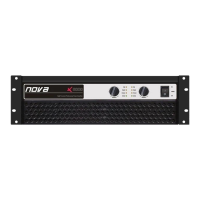Reference Manual
Page 6
Reference Manual
Page 7
12. Input Sensitivity/Gain
The standard settings are:1.4V,32dB,26dB,selection is independent for each channel. Use
this function to match the amplifier's sensitivity/gain with the other connected equipment.
As option, is possible adjust the unit for any sensitivity/gain.Note that every increase of the
gain will decrease the S/N ratio.
13. Mode operation switches
Setup these switches for the desired operation mode. For reference see
14. Speakon output connectors
The unit has four Speakon connectors as outputs: CH 1 and CH 2. Every one permit the con-
nection of both channels for stereo operation or parallel mode. For bridge operation the
CH1 connector should be used. For reference see
15. A.C. Power cable
The unit have one A.C. power cable. Before connection, be sure that the cable is not frayed
or broken. The connection must be made only in a plug with the electrical ground wire sys-
tem.
16. S.N. label
Every unit has a label indicating: the model, and the bar code serial number.
Figure 1.
Figure 1.
Operation
Grounding
There is no ground lift switch or terminal on this amplifier. The signal ground is always
floating via a resistor to chassis, and the grounding system is automatic. If a potential above
0.6V is presents in between signal ground and chassis ground, a short circuit is introduced
between the two, thereby enabling electrical protection. If a unit in the system is faulty, its
mains fuse will blow due to this automatic ground system. If however you wish to tie the sig-
nal ground to chassis, connect the XLR-connector`s shell lug to pin 1. In the interest of
safety never disconnect the earth pin on the AC power cord.
For all units that are FCC approved (radio interference), there is an AC mains filter. This fil-
ter needs the chassis ground for reference, otherwise a current loop is formed via the signal
ground. Use the balanced input to avoid hum and interference.
Connecting Power and Circuit size requirements
Amplifier's power requirement are rated at idle, at 1/8 and 1/3 power ("severe" music condi-
tion).The maximum power current draw rating is limited only by the internal fuses. Consult
the specification at the end of this manual for the power each amplifier will demand. Mains
voltage must also be correct and the same as that printed on the rear of the amplifier.
Damage caused by connecting the amplifier to improper AC voltage is not covered by any
warranty.
Note: always switch off and disconnect the amplifier from mains voltage before making
audio connections, and as an extra precaution, have the attenuators turned down during
power-up.
Cooling Requirements
Amplifier use a forced air cooling system to maintain a low, even operating temperature.
Drawn by a infinitely variable speed fans mounted inside the unit, air enters through the
front
grills with dust filter, and courses through the cooling fins of the heatsinks, which dissipates
power transistor heat, before exiting through the rear panel ports. Make sure that there is
enough space around the front of the amplifier to allow air to enter, and around the units to
allow the heated air to exit. If the amp is rack-mounted, do not use doors or covers on the
front and rear of the rack; the air must flow through the amplifier without resistance.
Note: whatever type of rack you are using, make sure that the heated air can escape freely,
and that there is not resistance to the intake of cool air through the front grill.
Configuration
Use the configuration switch configurate the amplifier to meet your requirements. The setup
must be done with the unit switched off. With the switches and jumpers is possible to
configurate the amplifier for the following functions:
Series
Series

